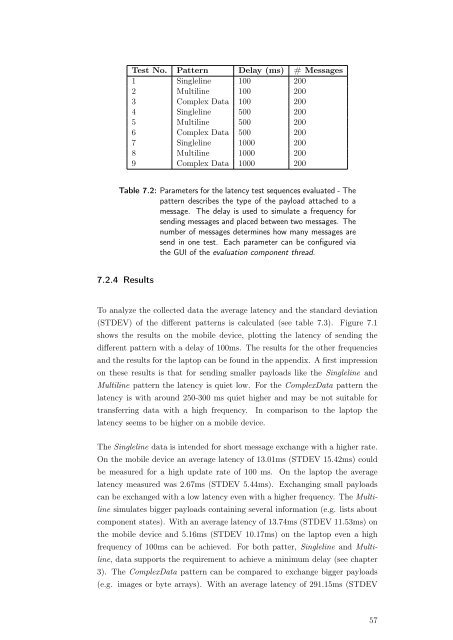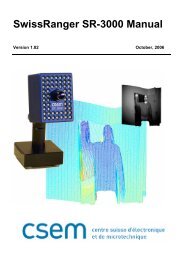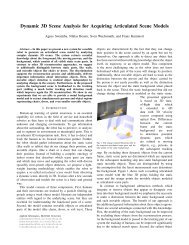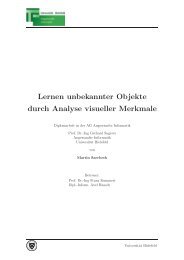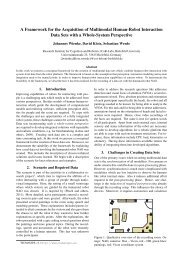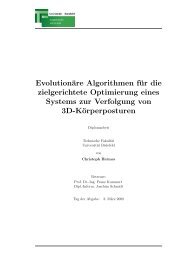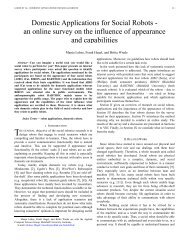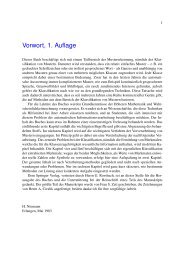System Introspection for System Analysis on Mobile Devices
System Introspection for System Analysis on Mobile Devices
System Introspection for System Analysis on Mobile Devices
You also want an ePaper? Increase the reach of your titles
YUMPU automatically turns print PDFs into web optimized ePapers that Google loves.
Test No. Pattern Delay (ms) # Messages1 Singleline 100 2002 Multiline 100 2003 Complex Data 100 2004 Singleline 500 2005 Multiline 500 2006 Complex Data 500 2007 Singleline 1000 2008 Multiline 1000 2009 Complex Data 1000 200Table 7.2: Parameters <str<strong>on</strong>g>for</str<strong>on</strong>g> the latency test sequences evaluated - Thepattern describes the type of the payload attached to amessage. The delay is used to simulate a frequency <str<strong>on</strong>g>for</str<strong>on</strong>g>sending messages and placed between two messages. Thenumber of messages determines how many messages aresend in <strong>on</strong>e test. Each parameter can be c<strong>on</strong>figured viathe GUI of the evaluati<strong>on</strong> comp<strong>on</strong>ent thread.7.2.4 ResultsTo analyze the collected data the average latency and the standard deviati<strong>on</strong>(STDEV) of the different patterns is calculated (see table 7.3). Figure 7.1shows the results <strong>on</strong> the mobile device, plotting the latency of sending thedifferent pattern with a delay of 100ms. The results <str<strong>on</strong>g>for</str<strong>on</strong>g> the other frequenciesand the results <str<strong>on</strong>g>for</str<strong>on</strong>g> the laptop can be found in the appendix. A first impressi<strong>on</strong><strong>on</strong> these results is that <str<strong>on</strong>g>for</str<strong>on</strong>g> sending smaller payloads like the Singleline andMultiline pattern the latency is quiet low. For the ComplexData pattern thelatency is with around 250-300 ms quiet higher and may be not suitable <str<strong>on</strong>g>for</str<strong>on</strong>g>transferring data with a high frequency. In comparis<strong>on</strong> to the laptop thelatency seems to be higher <strong>on</strong> a mobile device.The Singleline data is intended <str<strong>on</strong>g>for</str<strong>on</strong>g> short message exchange with a higher rate.On the mobile device an average latency of 13.01ms (STDEV 15.42ms) couldbe measured <str<strong>on</strong>g>for</str<strong>on</strong>g> a high update rate of 100 ms. On the laptop the averagelatency measured was 2.67ms (STDEV 5.44ms). Exchanging small payloadscan be exchanged with a low latency even with a higher frequency. The Multilinesimulates bigger payloads c<strong>on</strong>taining several in<str<strong>on</strong>g>for</str<strong>on</strong>g>mati<strong>on</strong> (e.g. lists aboutcomp<strong>on</strong>ent states). With an average latency of 13.74ms (STDEV 11.53ms) <strong>on</strong>the mobile device and 5.16ms (STDEV 10.17ms) <strong>on</strong> the laptop even a highfrequency of 100ms can be achieved. For both patter, Singleline and Multiline,data supports the requirement to achieve a minimum delay (see chapter3). The ComplexData pattern can be compared to exchange bigger payloads(e.g. images or byte arrays). With an average latency of 291.15ms (STDEV57


